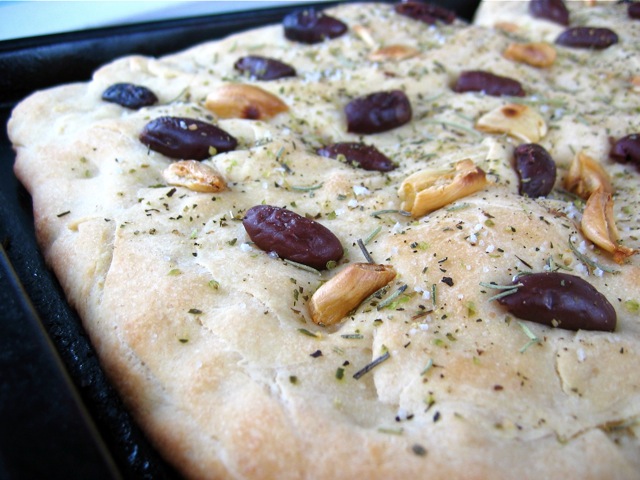
reference-image, l
(article, Christina Eng)
[%pageBreakSettings nobreak=true] The first time I made the chewy Italian flatbread known as focaccia, the dough refused to rise. It simply sat, bored and bewildered, a big lazy blob hanging out in a mixing bowl atop the kitchen counter. I tossed it reluctantly into the compost bin outside. Weeks earlier, my brother had brought over a store-bought, olive-and-onion focaccia. Soft, fresh, and flavorful, the bread had gone remarkably well with our simple supper of pasta with sausage and peppers. [[block(sidebar). h1.Featured recipes]] I am not a bread baker. But I wanted to recreate that bread. I figured that, in my years as a cook, I'd learned to follow directions fairly efficiently; how could a bread recipe be much different? So I browsed a few different sources, cobbled together a likely recipe, and set to work. After my first loaf ended in failure, I dug the discarded yeast packet I'd used for it out of the trash and checked the expiration date. Presumably, the last time I had attempted bread was more than a decade earlier, because that's how old my yeast was. I bought a new package of Fleischmann’s yeast and made a second attempt. This time, the dough rose only slightly. Had the water been too cold? Too hot? Had it generated a sort of fizz when it hit the yeast? I was stumped. [%image reference-image float=right width=400 caption="A flat loaf of olive-and-garlic focaccia."] But I soldiered on, ambitiously stretching my barely risen dough across a baking sheet before drizzling olive oil and scattering herbs across its surface. I dimpled the surface artistically with my fingers, pressing in handfuls of sliced olives and sautéed onions. Warm from the oven, the finished focaccia tasted fine. But it wasn't fluffy in the way I'd hoped. So I did a little research. According to Italian food authority Marcella Hazan, focaccia is most closely associated with Liguria, the Italian Riviera along the country's northwestern Mediterranean coast. In some Italian towns, she notes in Essentials of Classic Italian Cooking, focaccia is known as “pizza Genoese, Genoese-style pizza.” Focaccia does resemble pizza in some ways. It can have a similar texture, and often incorporates familiar pizza toppings such as basil, garlic, and mushrooms. Fortunately, however, it's seldom inundated with tomato sauce or drowned in melted cheese, making it easier to handle. Ordering focaccia in Italian bakeries, however, can be a tricky business. “In Bologna, if you’re looking for focaccia, the appropriate word to use is crescentina; in Florence, Rome, and a few other parts of central Italy, it is schiacciata," writes Hazan. "If you ask for focaccia in Bologna or Venice, you will be given a very sweet panettone-like cake, studded with candied fruit and raisins.” Focaccia can be eaten as a side to the main course, the way my brother and I approached our meal that night. It can be considered an appetizer, served warm perhaps with a lovely bowl of soup. Thick loaves can also be cut horizontally for sandwiches and filled with coppa and provolone, or prosciutto and slices of mozzarella, or a mix of grilled or roasted vegetables. Or you can eat it the way it's served in Ligurian bakeries: hot from the oven, wrapped in paper, and downed on the spot. I flipped through other cookbooks looking for focaccia recipes. In Lidia's Family Table, Lidia Bastianich includes a fig-studded focaccia. In How to Cook Everything (Completely Revised 10th Anniversary Edition), Mark Bittman's basic focaccia is essentially a glorified pizza-dough recipe, with eight different ideas for toppings. And Nick Malgieri gets wildly creative in his latest, The Modern Baker; the focaccia recipes here include such combinations as tomatoes, anchovies, and dried breadcrumbs; sliced onions, anchovies, and black and green olives; and prosciutto, mozzarella, and Parmigiano-Reggiano, for a ham-and-cheese-filled focaccia. Armed with ideas, I began my third loaf of focaccia. I added warm water to the yeast and watched it fizz. Then I proofed the dough in the warmest spot in the house: an upstairs bedroom with strong afternoon sun, nowhere near the kitchen. This time, the dough not only rose but ballooned, developing a satisfying elasticity. It stretched amiably and went into the oven contentedly. Cut and plated nicely, the completed focaccia looked terrific, speckled with the contrasting colors of black olives, red onions, and green herbs. Fluffier than the second loaf, the bread felt soft and slightly spongy; the toppings tasted savory and mildly sweet. I ate chunks of it at meal after meal, until nary a crumb remained. Why, I wondered, had focaccia even mattered? Why was it so important that I make my own bread instead of buying the perfectly delicious loaves available at the store? Maybe I was trying to impress my brother. But, more likely, I was trying to impress myself. p(bio). [christinaeng@hotmail.com "Christina Eng"] is a writer in Oakland, California.

reference-image, l